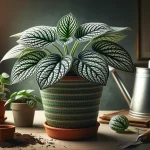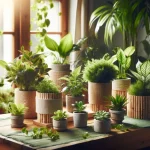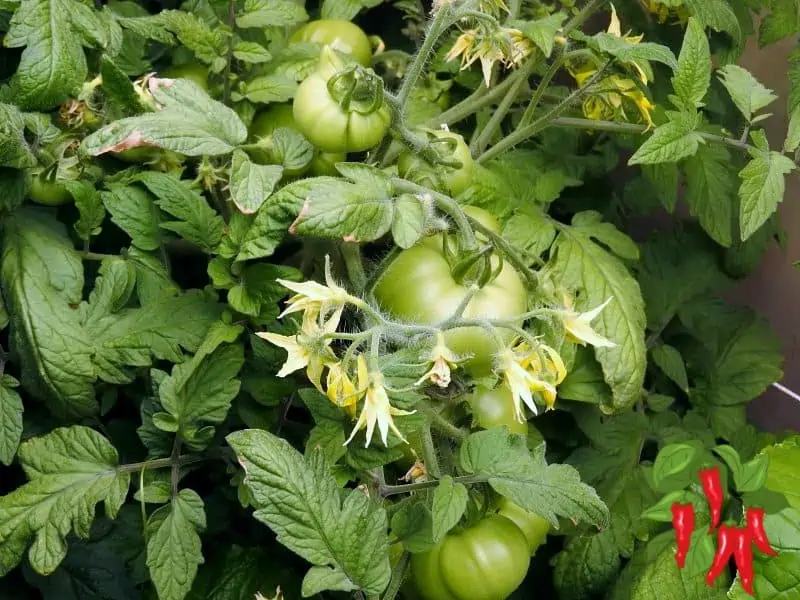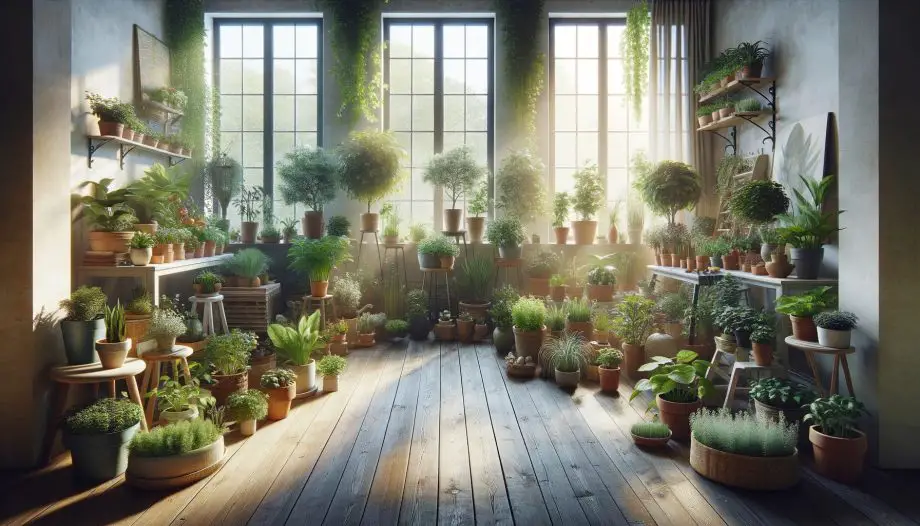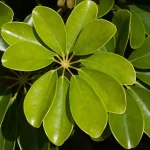This post may contain affiliate links. If you buy something from one of our links we may earn a commission. Thanks
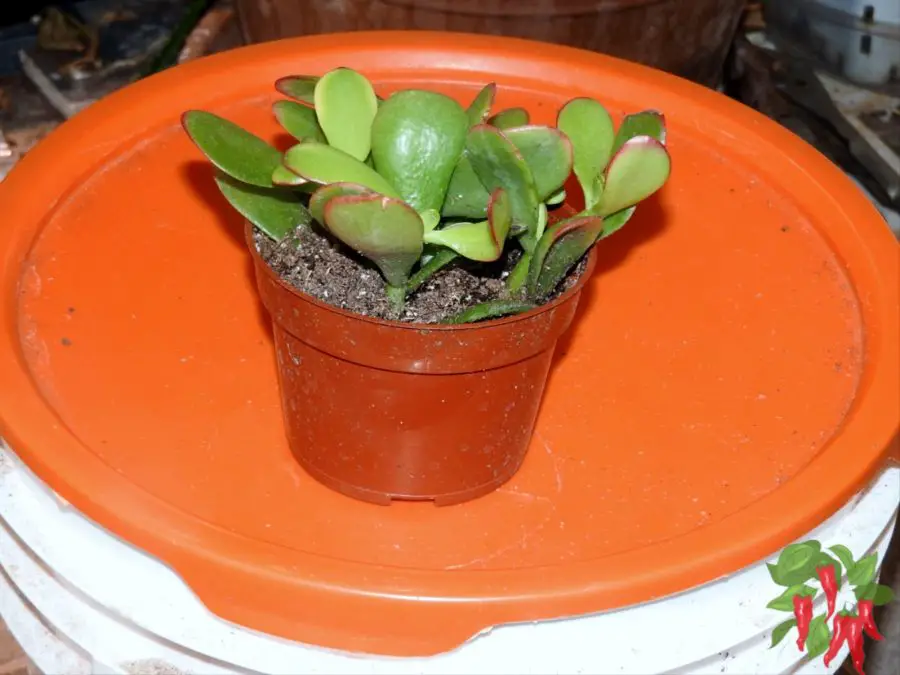
Indoor jade plant care doesn’t have to be a mystery, even if your past attempts haven’t gone as planned.
When these beautiful succulents start dropping leaves or looking less than lush, it’s easy to feel like you’re doing everything wrong.
But don’t give up – with a few simple tips and tricks you’ll learn how to take care of jade plant indoors you’ll soon be growing a thriving jade plant that can become a treasured part of your indoor garden for decades to come!
Indoor Jade Plant Care Key Takeaways:
- Indoor Jade Plant Care requires bright indirect light, well-draining soil, and moderate watering.
- These succulents thrive in temperatures between 60-75°F with low humidity.
- Water when the soil is dry, fertilize during the growing season, and protect from drafts.
- Regular pruning promotes healthy growth.
How To Take Care of Jade Plant Indoors

Jade Plant 4″ Crassulla Ovata Hummel’s Sunset Succulent Plants Live, Easy to Grow Hard to Kill Houseplant by The Succulent Cult
Wondering how to keep your jade plant thriving indoors? These beautiful succulents can live for decades, but many new plant parents struggle with proper care techniques.
Don’t worry – with some simple tips and a bit of understanding, you’ll be growing a healthy, prosperous jade plant that can become a family heirloom.
Understanding Your Jade Plant
The jade plant (Crassula ovata) is more than just a pretty succulent. Known for its thick, oval-shaped leaves and tree-like appearance, these resilient plants have become one of the most beloved houseplants worldwide.
Crassula ovata, commonly known as jade plant, lucky plant, money plant or money tree, is a succulent plant with small pink or white flowers that is native to the KwaZulu-Natal and Eastern Cape provinces of South Africa, and Mozambique; it is common as a houseplant worldwide. Much of its popularity stems from the low levels of care needed; the jade plant requires little water and can survive in most indoor conditions. https://en.wikipedia.org/wiki/Crassula_ovata
Understanding their basic characteristics is the first step to successful care.
Basic Characteristics
The jade plant’s distinctive features set it apart from other succulents. Its thick, fleshy leaves store water efficiently, making it drought-tolerant.
The stems gradually become woody as they age, creating a miniature tree-like appearance that can add an elegant touch to any room.
• Leaf Structure: The oval-shaped leaves grow in opposing pairs, developing a slight reddish tinge on the edges when exposed to adequate sunlight. This natural coloring indicates a healthy plant receiving proper light.
• Jade Plant Growth Pattern: While generally slow-growing, jade plants can reach impressive heights of 3-6 feet indoors when given proper care over many years. Their growth is typically most active during spring and summer months.
• Stem Development: Young stems start green and succulent-like, gradually developing a brown, woody texture that provides structural support as the plant matures. This transformation gives older jade plants their distinctive tree-like appearance.
Benefits of Growing Jade Plants
 Sunset Jade Plant – Crassula – Easy to Grow House Plant – 4″ Pot
Sunset Jade Plant – Crassula – Easy to Grow House Plant – 4″ Pot
These versatile plants offer more than just aesthetic appeal. Their presence in your home can provide numerous advantages:
Air Purification
Jade plants actively help clean indoor air by absorbing toxins and releasing oxygen. This natural filtration process is particularly effective during daylight hours, making them excellent additions to home offices or living spaces.
Longevity and Heritage
With proper care, jade plants can live for generations. Many families pass their plants down as living heirlooms, with some specimens surviving for 70-100 years. This longevity makes them meaningful gifts and family treasures.
Feng Shui Benefits
In many cultures, jade plants are considered powerful symbols of prosperity and good fortune. For this reason, they are often called Money Plants.
Their placement in homes and offices is thought to attract wealth and positive energy, particularly when positioned in the southeast corner of a room according to feng shui principles.
Low Maintenance Appeal
Once established, jade plants require minimal care compared to many other houseplants.
Their succulent nature makes them forgiving of occasional neglect, though they thrive with consistent care.
As you can see there are multiple Jade plant benefits for indoor gardeners.
Essential Indoor Jade Plant Care Requirements

Jade Plant – Crassula – Easy to Grow – Hard to Kill – Cactus – 4″ Pot- Living Succulant, Succulents Plant Live, Succulent Plants Fully Rooted, Houseplant for Home Office Decor
Creating the perfect environment for your jade plant starts with understanding its core needs. Like any houseplant, jades have specific requirements for light, water, soil, and temperature. Meeting these needs consistently will help your plant thrive and develop its characteristic robust appearance.
Jade Plant Light Requirements
Lighting is perhaps the most crucial factor in jade plant care. These succulents need specific light conditions to maintain healthy growth and develop their beautiful coloring.
Natural Light Placement
Jade plants thrive in bright, indirect sunlight for 4-6 hours daily. A south or west-facing window is ideal, providing the perfect balance of light intensity and duration. However, you’ll need to protect them from harsh afternoon sun, which can scorch their leaves. Consider using sheer curtains during peak sunlight hours to filter intense rays.
Signs of Improper Light
Watch your plant’s behavior to determine if it’s receiving appropriate light:
• Leggy growth with large spaces between leaves indicates insufficient light
• Pale or yellowing leaves might mean too much direct sun
• Deep green leaves with slight red tinting on edges show perfect light exposure
• Leaning or stretching toward light sources suggests the need for rotation
Seasonal Light Adjustments
As seasons change, so should your plant’s placement:
• Summer: Provide morning sun but protect from intense afternoon rays
• Winter: Move closer to light sources to compensate for shorter days
• Spring/Fall: Gradually adjust positioning to acclimate to changing light intensity
Water Requirements
Proper watering is essential for jade plant health, and it’s often where many plant parents make mistakes. Understanding when and how to water jade plants can prevent many common issues.
Watering Technique
 Shop Succulents Jade Succulent Plant, Crassula Ovata Fully Rooted Live 4″ Succulent Plant, Low Maintenance Indoor Plant, Hardy Succulents, Hard to Kill Plants, Wedding and Party Favors, Gift & Garden
Shop Succulents Jade Succulent Plant, Crassula Ovata Fully Rooted Live 4″ Succulent Plant, Low Maintenance Indoor Plant, Hardy Succulents, Hard to Kill Plants, Wedding and Party Favors, Gift & Garden
Deep but infrequent watering is key. This means thoroughly saturating the soil until water runs through the drainage holes, then allowing it to dry significantly before watering again. This approach encourages deep root growth and prevents surface root development.
Seasonal Watering Adjustments
Growing Season (Spring/Summer):
• Water when top 2 inches of soil feel dry
• Typically every 7-14 days depending on conditions
• Monitor soil moisture more frequently during hot weather
• Water early in the day to prevent overnight moisture
Dormant Season (Fall/Winter):
• Reduce watering frequency by about half
• Allow soil to dry more between waterings
• Watch for signs of overwatering like yellowing leaves
• Maintain consistent but reduced moisture levels
Signs of Proper Watering
Learning to read your plant’s signals helps maintain optimal moisture levels:
• Healthy Plant Indicators
• Firm, plump leaves
• Vibrant green color
• Sturdy stems
• Even growth pattern
Overwatering Signs
• Soft, mushy leaves
• Yellowing or translucent leaves
• Leaf drop
• Root rot (black, mushy roots)
Underwatering Signs
• Wrinkled, shriveled leaves
• Leaf drop (particularly lower leaves)
• Slow growth
• Dry, crispy leaf edges
Soil and Potting

Brussel’s Bonsai Live Dwarf Jade Bonsai Tree, Indoor – Small, 3 Years Old, 5 to 8 Inches Tall – Jade Tree in Decorative Ceramic Bonsai Pot
The foundation of a healthy jade plant lies in its soil and pot selection. Creating the right growing environment at the root level ensures your plant can access nutrients and moisture while maintaining proper drainage.
Creating the Perfect Soil Mix
Your jade plant’s soil needs to balance moisture retention with excellent drainage. Here’s how to create the ideal mix:
• Basic Soil Recipe
• 2 parts quality potting soil
• 1 part coarse sand or perlite
• 1 part pumice or crushed gravel
This combination provides the perfect balance of nutrients and drainage while preventing soil compaction.
Jade plant soil mix (Coco Coir)
Creating the perfect soil mix for your jade plant is crucial for its long-term health. While traditional potting mixes work well, I like using coco coir which can provide additional benefits for your plant’s root system.
Understanding Coco Coir Benefits
• Superior water retention while maintaining aeration
• Natural resistance to fungal growth
• Environmentally sustainable alternative to peat moss
• Excellent root development support
• pH neutral medium (5.8-6.8)
Creating a Coco Coir Mix
Basic Recipe
• 50% coco coir
• 25% perlite
• 10% worm castings or compost
Alternative Mix for Higher Drainage
• 50% coco coir
• 50% perlite
Additional Soil Considerations
• pH Level: Maintain slightly acidic to neutral (6.0-7.0)
• Texture: Should feel gritty and loose, never compacted
• Organic Content: Include some organic matter for nutrients
• Drainage: Water should flow through easily when tested
Choosing the Right Pot
 Jade Plant 4″ Crassula Ovata Jade Compact Succulent Plants Live, Easy to Grow Hard to Kill Houseplant by The Succulent Cult
Jade Plant 4″ Crassula Ovata Jade Compact Succulent Plants Live, Easy to Grow Hard to Kill Houseplant by The Succulent Cult
The perfect pot is crucial for jade plant health. Consider these factors when selecting a container:
Size and Material
• Choose a pot only 1-2 inches larger than the root ball
• Select heavy materials like ceramic or terracotta to prevent tipping
• Ensure multiple drainage holes for proper water flow
• Consider the pot’s depth based on root system development
Repotting Jade Plants
Knowing when and how to repot your jade plant is crucial for its continued growth and health.
These sturdy succulents typically need repotting every 2-3 years, or when they become root-bound in their current container.
Signs It’s Time to Repot
• Roots growing through drainage holes
• Water runs straight through the pot
• Plant becomes top-heavy or unstable
• Growth slows significantly
• Soil dries out very quickly
Repotting Steps
1. Timing
• Best done in spring before active growth
• Avoid repotting during dormancy
• Wait 2-3 weeks after last watering
2. Container Selection
• Choose pot 1-2 inches larger than current
• Ensure adequate drainage holes
• Use heavy materials like ceramic or terracotta
• Avoid oversized pots which retain excess moisture
3. Process
• Gently remove plant from current pot
• Inspect and trim damaged roots
• Place in new pot at original soil level
• Fill with fresh well-draining soil mix
• Wait one week before watering
Post-Repotting Care
• Place in bright, indirect light
• Hold off fertilizing for 4-6 weeks
• Monitor for signs of transplant shock
• Resume normal care once established
Temperature and Humidity
 Jade Plant 4″ Crassulla Gollum Jade Succulent Plants Live, Easy to Grow Hard to Kill Houseplant by The Succulent Cult
Jade Plant 4″ Crassulla Gollum Jade Succulent Plants Live, Easy to Grow Hard to Kill Houseplant by The Succulent Cult
Creating the right environmental conditions helps your jade plant thrive. These succulents prefer specific temperature ranges and humidity levels for optimal growth.
Temperature Management
Ideal Temperature Range:
• Daytime: 65-75°F (18-24°C)
• Nighttime: No lower than 55°F (13°C)
• Avoid sudden temperature fluctuations
• Protect from cold drafts and heat sources
Seasonal Temperature Considerations
• Summer Protection
• Shield from air conditioning vents
• Provide adequate ventilation
• Monitor for heat stress during peak temperatures
Winter Care
• Keep away from cold windows
• Protect from heating vents
• Maintain consistent room temperature
• Watch for cold damage signs
Humidity Requirements
Unlike many tropical houseplants, jade plants prefer lower humidity levels, making them perfect for most indoor environments.
Optimal Humidity Levels
• 30-50% relative humidity is ideal
• No need for additional humidity in most homes
• Avoid misting leaves, which can lead to fungal issues
• Ensure good air circulation to prevent moisture-related problems
Fertilizing Jade Plants Guidelines
 Jade Plant 4″ Crassulla Ovata Tricolor Variegated Jade, Succulent Plants Live, Easy to Grow Hard to Kill Houseplant by The Succulent Cult
Jade Plant 4″ Crassulla Ovata Tricolor Variegated Jade, Succulent Plants Live, Easy to Grow Hard to Kill Houseplant by The Succulent Cult
Proper fertilization is essential for your jade plant’s long-term health and growth. While these plants aren’t heavy feeders, they benefit from regular, balanced nutrition during their growing season.
Understanding Fertilizer Needs
Seasonal Feeding Schedule:
Spring/Summer (Active Growth)
• Apply fertilizer every 4-6 weeks
• Use balanced, water-soluble fertilizer (10-10-10)
• Dilute to half strength to prevent root burn
• Feed only when soil is moist
Fall/Winter (Dormancy)
• Stop fertilizing completely
• Resume feeding in early spring
• Watch for signs of nutrient deficiency
• Avoid feeding stressed or sick plants
Signs of Fertilizer Issues
Over-Fertilization
• White crust on soil surface
• Leaf burn or browning edges
• Rapid, weak growth
• Root damage
Under-Fertilization
• Pale or yellowing leaves
• Slow or stunted growth
• Small new leaves
• Reduced leaf thickness
Pruning and Maintenance
 Live Succulent ‘Trumpet Jade’, Approx 2″ Large, Rare Succulent Plants Fully Rooted in Pots, Unique House Plant for DIY, Party Favor, Home Office Decoration
Live Succulent ‘Trumpet Jade’, Approx 2″ Large, Rare Succulent Plants Fully Rooted in Pots, Unique House Plant for DIY, Party Favor, Home Office Decoration
Regular pruning and maintenance are crucial for keeping your jade plant healthy and aesthetically pleasing.
A well-pruned jade plant develops a strong structure and maintains its desired shape.
Proper Pruning Techniques
Timing and Tools
• Best pruning season: Early spring before new growth
• Use clean, sharp pruning shears
• Sterilize tools between cuts
• Make clean cuts just above leaf nodes
Strategic Pruning Goals
• Remove dead or yellowing leaves promptly
• Trim leggy growth to encourage bushiness
• Control size and shape
• Promote branching for fuller appearance
Advanced Shaping Methods
• Pinch growing tips to encourage branching
• Remove up to 20% of growth at once
• Balance the overall appearance
• Consider artistic shaping for bonsai-style growth
Post-Pruning Care
• Allow cuts to dry for 24-48 hours
• Reduce watering until new growth appears
• Monitor pruned areas for signs of stress
• Save healthy cuttings for propagation
Jade Plant Propagation Methods
 Altman Plants Live Jade Plant Collection (4PK), Classic Jade Plants in 2.5″ Pots, Mini Succulents, Sunset Jade, Live Succulents, Crassula Ovata, Variegated Live Plants & House Plants in Succulent Soil
Altman Plants Live Jade Plant Collection (4PK), Classic Jade Plants in 2.5″ Pots, Mini Succulents, Sunset Jade, Live Succulents, Crassula Ovata, Variegated Live Plants & House Plants in Succulent Soil
Jade plants are relatively easy to propagate, offering multiple ways to create new plants from your existing specimen.
Leaf Propagation Detailed Steps
1. Select healthy, full leaves
• Choose mature, unblemished leaves
• Gently twist off entire leaf with base intact
• Allow removal site to callus
2. Prepare for Rooting
• Let leaves dry for 2-3 days
• Place on well-draining soil
• Position in bright, indirect light
• Maintain slight soil moisture
3. Monitor Progress
• Roots develop in 2-4 weeks
• Small plantlets appear at leaf base
• Original leaf eventually withers
• Transfer to permanent pot when established
Common Problems and Solutions
Even with the best care, jade plants can encounter various issues. Understanding how to identify and address common problems quickly is key to maintaining a healthy plant.
Pest Management – Common Pests Identification and Treatment
Mealybugs
• Appearance: White, cotton-like clusters on leaves and stems
• Damage: Sap drainage, weakened growth, sticky residue
• Treatment:
• Isolate infected plant immediately
• Remove visible bugs with alcohol-dipped cotton swab
• Apply insecticidal soap or neem oil solution
• Repeat treatment weekly until resolved
Spider Mites
• Signs: Fine webbing, tiny moving dots, stippled leaves
• Prevention:
• Maintain proper humidity
• Regular leaf cleaning
• Good air circulation
• Control:
• Spray leaves with strong water stream
• Apply miticide if infestation is severe
• Treat weekly until eliminated
Disease Prevention and Treatment
Root Rot Causes:
• Overwatering
• Poor drainage
• Compacted soil
• Symptoms:
• Yellowing leaves
• Soft, mushy stems
• Black, mushy roots
Treatment:
• Remove affected roots
• Repot in fresh, dry soil
• Reduce watering frequency
• Improve drainage conditions
Powdery Mildew Identification:
• White, powdery coating on leaves
• Usually appears in humid conditions
• Can spread rapidly if untreated
• Solutions:
• Improve air circulation
• Reduce humidity
• Apply fungicidal treatment
• Remove severely affected leaves
Environmental Stress Management
Temperature Stress
• Cold Damage:
• Blackened leaves
• Soft, mushy tissue
• Leaf drop
• Heat Stress:
• Sunburned patches
• Wilting despite adequate water
• Dried leaf edges
Light Stress
• Too Much Light:
• Bleached or yellowed leaves
• Red leaf edges
• Dried patches
• Too Little Light:
• Elongated stems
• Pale leaves
• Reduced growth
Caring for Indoor Jade Plants FAQs
Understanding your jade plant’s needs can raise many questions. Here are detailed answers to the most common queries plant parents have about jade plant care.
Q: Why are my jade plant’s leaves falling off?
A: Leaf drop can occur for several reasons:
• Overwatering: Most common cause, check root health
• Underwatering: Leaves fall after becoming wrinkled
• Temperature shock: Sudden temperature changes
• Natural shedding: Normal for lower, older leaves
Solution: Identify the cause and adjust care accordingly. Most jade plants recover quickly once the underlying issue is addressed.
Q: How can I make my jade plant bushier?
A: Several techniques promote bushy growth:
• Regular pruning of growing tips
• Adequate light exposure
• Proper fertilization during growing season
• Consistent, appropriate watering
Time and patience are key – results become visible over several months of consistent care.
Q: Why are my jade plant’s leaves wrinkling?
A: Leaf wrinkling typically indicates moisture issues:
• Primary causes:
• Underwatering most common
• Root problems preventing water uptake
• Excessive heat causing moisture loss
• Solutions:
• Check soil moisture at root level
• Adjust watering schedule
• Evaluate root health
• Monitor environment temperature
Q: When should I repot my jade plant?
A: Timing repotting correctly is crucial:
• Signs it’s time to repot:
• Roots growing through drainage holes
• Plant becomes top-heavy
• Soil dries out very quickly
• Growth has slowed significantly
• Best repotting practices:
• Repot in spring before active growth
• Choose pot only 1-2 sizes larger
• Use fresh, well-draining soil
• Wait 1-2 weeks before watering deeply
Q: How can I encourage my jade plant to bloom?
A: Jade plants need specific conditions to flower:
• Key factors:
• Mature age (usually 5+ years)
• Cool night temperatures (50-55°F)
• Reduced watering in fall/winter
• Bright light but shorter day length
• No fertilizer during dormancy period
Q: Is my jade plant getting enough light?
A: Look for these indicators:
• Signs of adequate light:
• Compact growth
• Thick stems
• Red-tinged leaf edges
• Vibrant green color
• Signs of insufficient light:
• Leggy growth
• Pale leaves
• Stretched stems
• Leaf drop
Indoor Jade Plant Care Conclusion
Creating the Perfect Environment
Successfully growing a jade plant indoors requires understanding and meeting its basic needs while being attentive to changes in its appearance and growth patterns.
With proper care, these resilient plants can become stunning focal points in your home and last for generations.
Seasonal Care Adjustments
Spring Care (March-May)
• Increase watering gradually
• Resume fertilization schedule
• Begin pruning and shaping
• Monitor for new growth
• Check for winter damage
Summer Maintenance (June-August)
• Protect from intense sun
• Maintain regular watering
• Continue fertilization
• Monitor for pest issues
• Consider outdoor placement
Fall Preparation (September-November)
• Reduce watering frequency
• Stop fertilizing
• Move to protected location
• Begin dormancy care
• Check for drafts
Winter Protection (December-February)
• Minimal watering
• No fertilizer
• Maintain temperature
• Protect from cold
• Monitor humidity
Decorative Uses and Design
Creating Displays
• Use as focal points in bright rooms
• Pair with other succulents
• Consider size and scale
• Match pot style to decor
• Group plants effectively
Feng Shui Placement
• Southeast corner for wealth
• East for health and family
• South for fame and reputation
• Avoid bathrooms and bedrooms
• Keep away from negative spaces
Key Takeaways
• Provide consistent care but avoid overattention
• Monitor plant’s signals for care adjustments
• Focus on proper watering techniques
• Ensure adequate but appropriate light
• Use well-draining soil mix
• Maintain stable temperature range
• Practice regular maintenance
• Address issues promptly
• Be patient with growth rate
• Keep records of care routine
• Learn plant’s seasonal needs
• Enjoy the journey of growing your jade
By following these guidelines and paying attention to your plant’s needs, you can enjoy a healthy, thriving jade plant that brings beauty and positive energy to your space for years to come.
Remember that each plant is unique, and part of the joy of plant parenthood is learning your individual plant’s preferences and patterns.
Read more: Indoor Apartment Gardening: 15 Point Comprehensive Guide
Visit my Amazon Influencer Page for videos and gardening products Grow Your Own Garden


